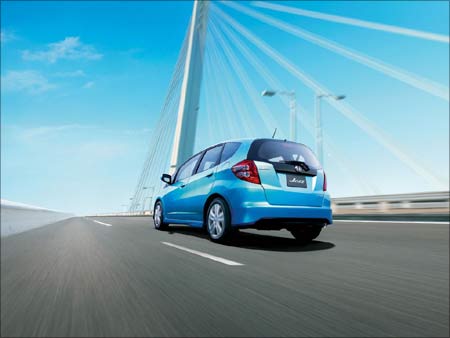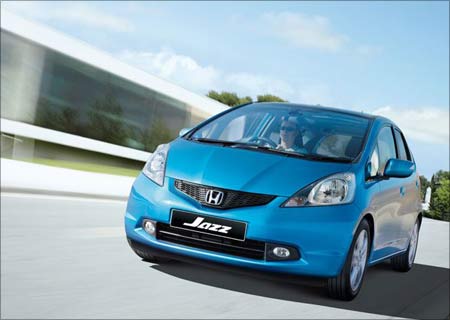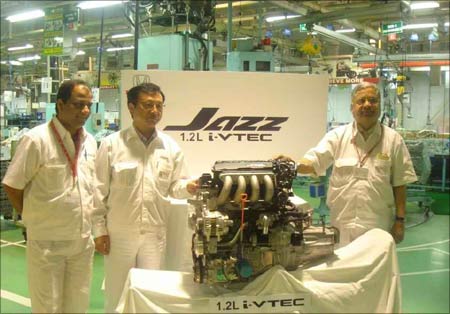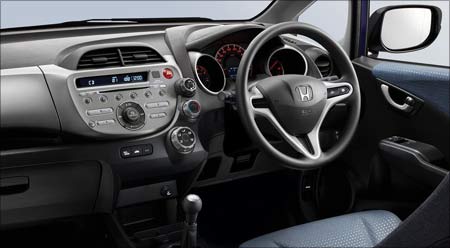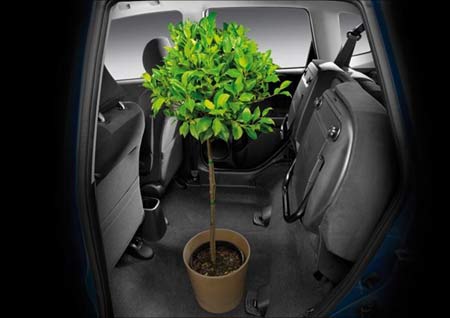 | « Back to article | Print this article |
Sneak peek: Honda Jazz to roll out on June 10
Honda, despite it grip on India's sedan sector, is still a relatively small player in the country's automobile market because of the absence of a small car in its portfolio.
But all that is about to change as Honda plans to launch its premium hatchback, Jazz, on June 10, in India.
Yes, India is a country of the hatchbacks. Every so often, various carmakers launch newer and better hatchbacks to capture one of largest small car markets in the world.
Maruti Suzuki which has more than 50 per cent market share virtually rules the small car market. It sells almost seven hatchbacks, including the very recently launched Ritz.
Honda, which has been successful in every segment that it is present, wants to try its hand at the most competitive small car market in India with the Jazz.
Can Honda Jazz replicate the success that began with the Maruti 800 and wean away customers of Maruti Suzuki, Hyundai and Tata Motors? It remains to be seen.
Here we give you a sneak peek on the much-awaited Honda's Jazz.
Text: Karthick Annamalai
The author is an automobile enthusiast and also blogs on www.vicky.in
Jazz may be priced at Rs 6-7 lakh
Built on the same platform as the new Honda City, Honda Jazz is modern and pleasing. The styling is not really revolutionary, but its razor-sharp edges give it a very modern look.
Jazz sports a unique forward-leaning cabin form styling that highlights sharper lines, wider stance and aerodynamical styling.
A distinctive honeycomb grille is matched with larger, more sharply styled headlights to create an assertive look. However, the tall boy design necessitates a raked up windscreen and high roofline.
Overall the Jazz inherits the styling of modern Japanese cars to create a sporty and dynamic form. Reflecting the sporty appeal, the mechanicals are tuned to provide a sporty, solid and dynamic driving experience.
Jazz employs MacPherson strut suspension in the front and torsion beam suspension at the rear. Let's check out what Jazz has under its hood. . .
It sports an impressive 1.2 lt i-VTEC engine
The 4-cylinder, 1198-cc engine featuring Programmed Fuel Injection pumps out a peak power of 90 PS at 6,200 rpm and a peak torque of 110 Nm at 4800 rpm.
According to ARAI -- the country's premier automotive research agency which tests all vehicles sold in India -- the Honda Jazz returned 16.1 km per litre under standard conditions. But the fuel efficiency figure is lower than that of the recently launched Maruti Ritz.
According to Honda, the i-VTEC regulates the opening of air-fuel intake valves and exhaust valves in accordance with engine speeds. By regulating valve opening to match engine speed, the agile i-VTEC engine adjusts its characteristics to realise both superior power and low fuel consumption.
Honda is well-known in India for its superior refinement and ultra-frugal engine and we can expect the same from the smaller i-VTEC.
A diesel version might follow
In fact, the absence of any prominent oil burner other larger i-CTDI engine is a worrying factor for the Japanese maker. Especially in markets like India where price difference between petrol and diesel is huge, demand for diesel cars is shooting up.
"We do feel the necessity of having a smaller diesel engine and are seriously studying the possibility. The development from scratch takes around three years. India is so popular for diesel cars because of high price difference - as much as 30% -- between petrol and diesel. India is the only major country in the world with such price differentials. In countries such as China, (those in) Europe, and Japan, this difference is only 10-12%," Masahiro Takedagawa, president and CEO, Honda Siel Cars India, said.
Anyway, Honda would need at least three years to come up a smaller diesel engine till then i-VTEC is the face of Honda.
Brilliantly designed for more space
The Jazz is bigger in every significant dimension but it is just under 4 meters in length to comply with small car excise duty. But Honda's incredible packaging ability frees up space for occupants rather than the mechanicals.
The fuel tank is chucked under the front seats instead of regular under boot position to create room for rear passengers. The cargo space is brilliant: even when the rear seats are up, there is 399 litres of space.
The huge boot is complete with under-floor storage and flat folding rear seats at the pull of a handle. Additionally, the rear seat squabs can be hinged upwards to create a storage space in the middle of the car.
Honda Civic-style dash bits give an upmarket look to the Jazz. Honda is expected to pack the Indian Jazz with a list of goodies to lure young customers.
The top-end variant will come with a steering wheel mounted audio control, ABS and airbags. There is no clarity yet on whether the Jazz will get alloy wheels, unlike the recently launched City.
Honda will soon have more competition
Apart from the cars listed in the last slide, we will have premium hatch from Volkswagen, General Motors and Toyota before the end of 2010. Pricing would be the key when equally superior cars compete with each other.
The same holds true in this segment. Honda is expected to price the Jazz in the Rs 6-7 lakh (Rs 600,000-700,000) range: this means at a premium over its competitors.
The Honda Jazz will be manufactured at Honda's mother plant in Greater Noida near Delhi. The plant's capacity has recently been increased to 100,000 units a year.
Will the Jazz create a buzz?
Impressed with the Honda Jazz? Wait! Before you sign that cheque, check out these hot hatches:
Skoda Fabia
For: India's first premium hatchback, Skoda brand,solid bulid, superior ride quality and diesel
Against: Pricey and after sales service
Maruti Suzuki Ritz
For: On the grille holds Suzuki's badge, proven diesel engine and spacious interiors
Against: Small boot
Hyundai i20
For: Value for money product and safety
Against: Engine lacks the punch
So will the Honda Jazz make its footprint in the price-sensitive small car segment and customers make a beeline for the jazz at Honda showrooms. We have to wait till the sales numbers are out.

